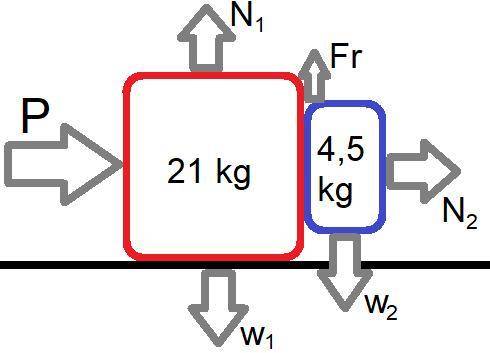
Physics, 12.10.2019 01:30 alemicsho2397
The drawing shows a large cube (mass = 21.0 kg) being accelerated across a horizontal frictionless surface by a horizontal force p. a small cube (mass = 4.5 kg) is in contact with the front surface of the large cube and will slide downward unless p is sufficiently large. the coefficient of static friction between the cubes is 0.710. what is the smallest magnitude that p can have in order to keep the small cube from sliding downward?

Answers: 1


Another question on Physics

Physics, 22.06.2019 10:00
Suppose a wheel with a tire mounted on it is rotating at the constant rate of 2.15 times a second. a tack is stuck in the tire at a distance of 0.373 m from the rotation axis. noting that for every rotation the tack travels one circumference (a) find the tack's tangential speed. (b) what is the tacks radial acceleration?
Answers: 2

Physics, 22.06.2019 10:30
Aparticle moves in the xy plane with constant acceleration. at time zero, the particle is at x = 6 m, y = 8.5 m, and has velocity ~vo = (9 m/s) ˆı + (−2.5 m/s) ˆ . the acceleration is given by ~a = (4.5 m/s 2 ) ˆı + (3 m/s 2 ) ˆ . what is the x component of velocity after 3.5 s? answer in units of m/s.
Answers: 1

Physics, 22.06.2019 11:20
More solar radiation is absorbed by earth’s surface than by
Answers: 1

Physics, 22.06.2019 16:30
The ph is the a.independent variable b.the dependent variable c.control group
Answers: 1
You know the right answer?
The drawing shows a large cube (mass = 21.0 kg) being accelerated across a horizontal frictionless s...
Questions


English, 27.10.2020 19:30


Arts, 27.10.2020 19:30



English, 27.10.2020 19:30


Mathematics, 27.10.2020 19:30

English, 27.10.2020 19:30

Geography, 27.10.2020 19:30

Mathematics, 27.10.2020 19:30

Mathematics, 27.10.2020 19:30


English, 27.10.2020 19:30

Chemistry, 27.10.2020 19:30

English, 27.10.2020 19:30

Mathematics, 27.10.2020 19:30

English, 27.10.2020 19:30

 whose value is to be found. That cube has its own weight
whose value is to be found. That cube has its own weight  , and it is associated with the force of gravity which points downward. Newton's third law stipulates that the response from the floor is an upward pointing force on the cube, and it's called the normal force
, and it is associated with the force of gravity which points downward. Newton's third law stipulates that the response from the floor is an upward pointing force on the cube, and it's called the normal force  .
. pointing downwards, but the normal force in this block doesn't point upwards since its 'floor' isn't below it, but in its side, therefore the normal force directs it to the right as it is shown in the picture. Normal forces are perpendicular to the surface they contact. The final force is the friction between both cubes, that sets a resistance of one moving parallel the other. In this case, the weight of the block its the force pointing parallel to the contact surface, so the friction opposes that force, and thus points upwards. Friction forces can be set as
pointing downwards, but the normal force in this block doesn't point upwards since its 'floor' isn't below it, but in its side, therefore the normal force directs it to the right as it is shown in the picture. Normal forces are perpendicular to the surface they contact. The final force is the friction between both cubes, that sets a resistance of one moving parallel the other. In this case, the weight of the block its the force pointing parallel to the contact surface, so the friction opposes that force, and thus points upwards. Friction forces can be set as  , where
, where  is the coefficient of static friction between the cubes.
is the coefficient of static friction between the cubes. Since the idea is that it doesn't slips downwards, the vertical acceleration should be set to zero
Since the idea is that it doesn't slips downwards, the vertical acceleration should be set to zero  , and making explicit the other forces:
, and making explicit the other forces:  [N]. In the last equation gravity's acceleration was rounded to 10 [m/s
[N]. In the last equation gravity's acceleration was rounded to 10 [m/s ].
]. , this time the horizontal acceleration is not zero, because it is constantly being pushed. However, the value of the normal force and the mass of the block are known, so its horizontal acceleration can be determined:
, this time the horizontal acceleration is not zero, because it is constantly being pushed. However, the value of the normal force and the mass of the block are known, so its horizontal acceleration can be determined:  [m/s
[m/s , since the force
, since the force  [N]. The resulting force is quite high but not impossible to make by a human being, this indicates that this feat of friction suspension is difficult but feasable.
[N]. The resulting force is quite high but not impossible to make by a human being, this indicates that this feat of friction suspension is difficult but feasable.


